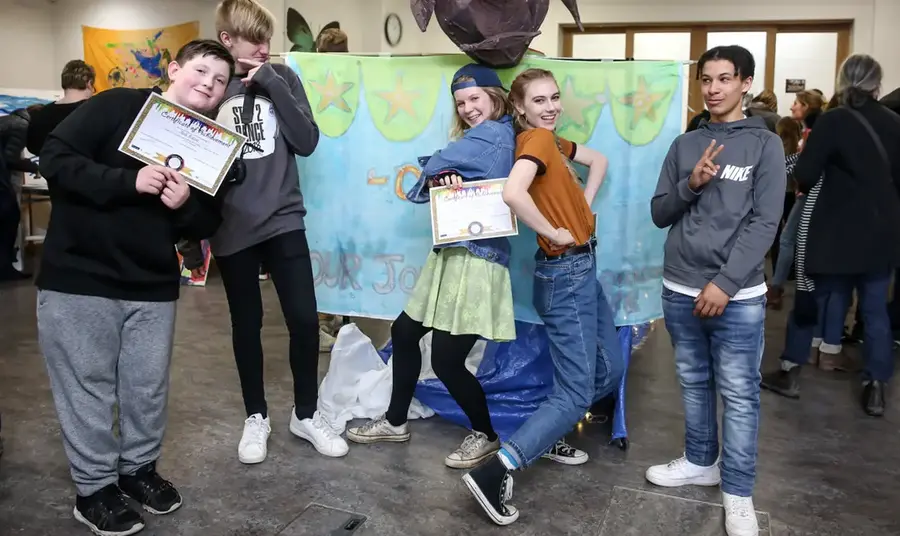
Young Roots
Oxfordshire Youth Arts Partnership and the Pitt Rivers Museum joined forces to work with young people struggling in mainstream school, supporting them to discover and interpret collections from around the globe.
The two-year project supported vulnerable young people experiencing social and mental health issues to develop creative, heritage and vocational skills by producing their own exhibitions, events and peer-learning sessions. The approach was innovative, creative and inclusive, putting young people at the centre of planning and activities.
“Kick Arts has helped me overcome the challenges... It’s felt like the whole world was against me... Now I look at life differently.”
Leigh, participant
The project had two elements. Kick Arts was a participation project through which young people creatively interpreted the ethnographic and natural history collections. An additional youth leadership programme created a pathway from the creative work into the museum’s existing Youth Action Team (‘Pitt YAT’).
Making a difference
- The project reached young people new to the museum and allowed them to learn about heritage in informal, flexible and supportive ways. The young people were either at risk of exclusion, not in education, employment or training (NEET), or experienced additional learning needs or disabilities; some benefited from taking time out of traditional classroom settings which they found stressful and challenging.
- Young people explored and interpreted the collections on their own terms. They learned a range of heritage interpretation methods, including film, illustration, music, fine art and digital media.
- The participants created a final exhibition and proudly opened it to the public and to family members and friends.
- Following the exhibition, young people were invited back into the museum to design a peer-learning opportunity. Choosing objects to create object-handling sessions for local schoolchildren, they further shared their learning.
- The Pitt YAT group created their own manifesto and branding and had significant input into a range of public events and displays the museum.
- Pitt Rivers staff worked in new ways with young people; they have deepened their understanding of how to address wellbeing issues using a sustained programme of creative activity.
- In evaluation, young people described positive impacts on their wellbeing: “It’s helped me massively figure out myself, who I want to become”; “I am less angry about everything – I’m just seeing things in a better way”; “I feel like I’ve gained more confidence … and it’s changed my behaviour. I haven’t had one detention since I’ve been here…”
Lessons learnt
Pitt Rivers adjoins the Natural History Museum (NHM), sharing the same building. Staff had to strengthen their relationship with NHM colleagues to deliver the project successfully. As a result, as intended, the young people were allowed to wander freely between the institutions and take inspiration from wherever they found it.
Young people were recruited through school referral systems, and processes could be challenging. Stronger partnerships between schools and the project lead might have helped to ensure higher referrals, lower dropout rates, and better communication.
Multiple stakeholders felt that the Kick Arts programme should have been longer. Parents, and participants, in particular, noted in evaluation the wish to see the development opportunities extended.
The progression route (for those who were ready for this level of engagement) was planned from the beginning and for some helped maintain a sense of belonging in the project. This pathway meant Kick Arts participants could take a step up in their engagement with the museum whilst maintaining a sense of continuity and support from staff.
When working with young people considered NEET, at risk of exclusion or with additional needs, managing group dynamics can be challenging. Taking time to build positive relationships from the beginning helped to ensure that the sessions were inclusive and offered an open platform for engagement.
As a result, some experiences were particularly powerful. One young person had been excluded from school a number of times for physical assault, substance misuse and damage to property. He struggled with self-confidence and had complex personal needs. School identified English was his ‘least successful’ subject saying he ‘chooses to disengage’.
At the start of the project he was immediately taken with the Manyshots Robe in the Pitt Rivers Museum, which documented a warrior's journey through space and time as a storyskin. He chose to create his own storyskin, telling his story from birth and identifying the successes and challenges, or “battles” in his life. He worked through his past to turn it first into a visual story and later one with words, poignantly demonstrating creative writing skills. He progressed to create a music track and video, debuted at the Kick Arts exhibition event.